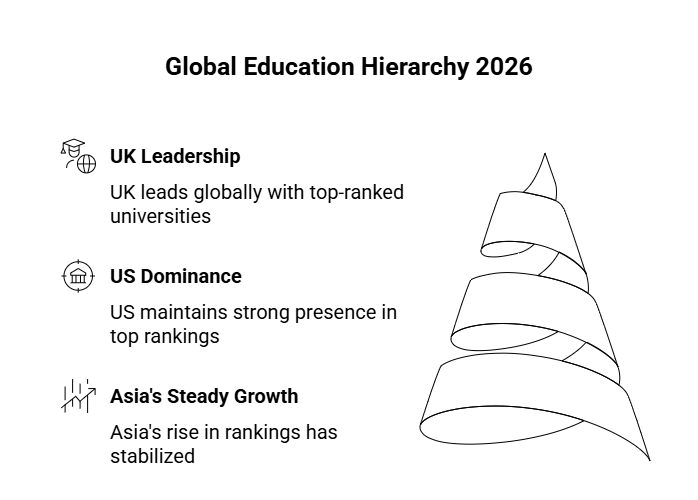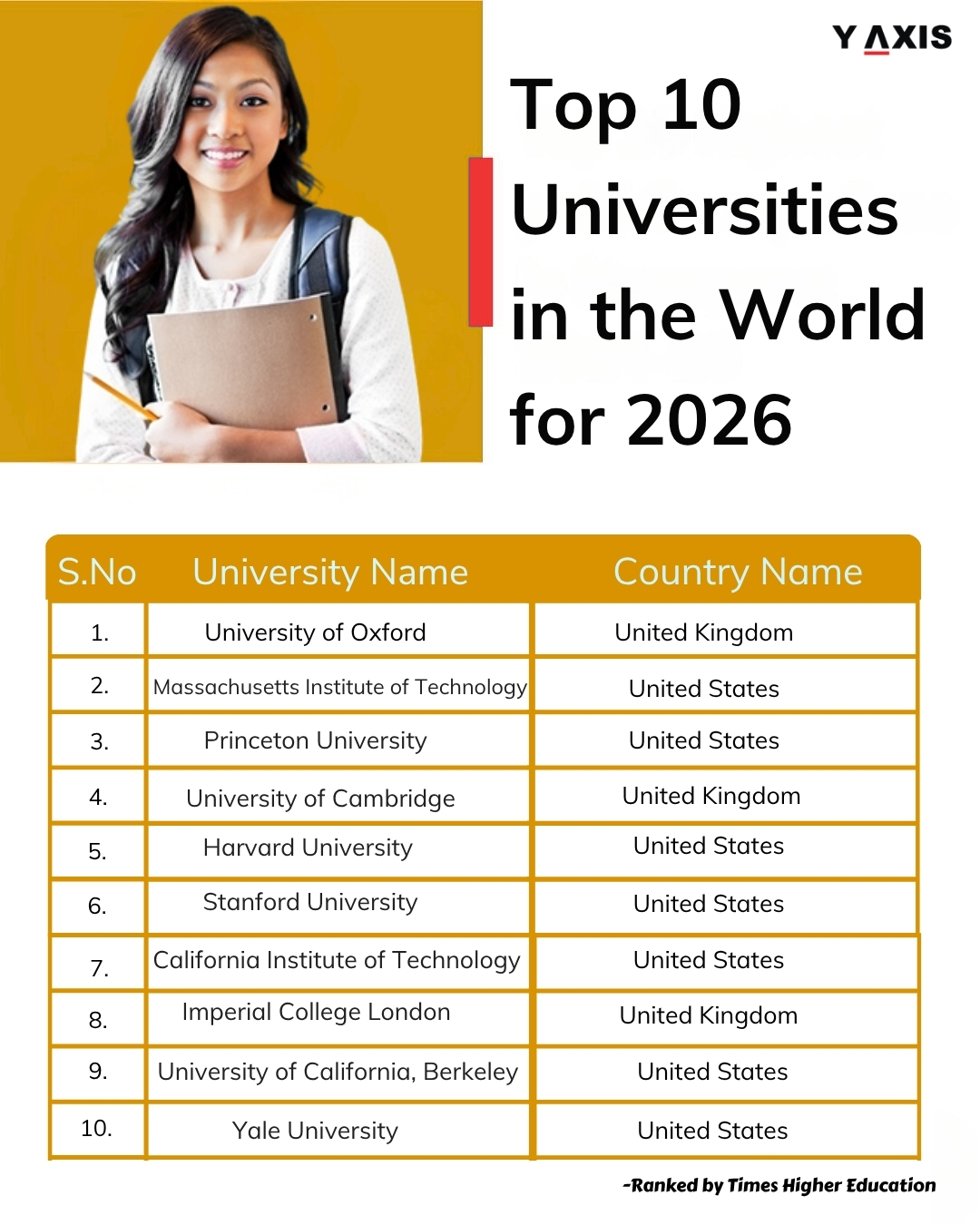Posted on October 11 2025
Best Universities in the World 2026 Announced by Times Higher Education. See Which University Topped the Chart!
By , Editor
Updated October 11 2025
Highlights: Oxford Leads the World University Rankings 2026 for a Record 10th Year
- The University of Oxford has been named the world’s best university for the 10th consecutive year, according to the Times Higher Education (THE) World University Rankings 2026.
- The United States continues to lead globally, with seven universities featured in the top 10, including MIT, Harvard, and Stanford.
- The United Kingdom remains strong, with Cambridge sharing the 3rd spot and Imperial College London ranked 8th.
- Asia’s leading institutions—Tsinghua (12th), Peking (13th), and National University of Singapore (17th)—maintain their global standing.
- India’s higher education sector shows growing potential through research-driven initiatives and expanding international collaborations.
*Want to study abroad? Let Y-Axis guide you with the process.
Top 10 Universities in the World 2026
The Times Higher Education (THE) World University Rankings 2026 highlight the institutions setting global benchmarks for excellence in teaching, research, and innovation. This year’s rankings reflect a strong presence from the United Kingdom and the United States, which continue to dominate the top spots.
The University of Oxford leads the list for the 10th consecutive year, followed closely by the Massachusetts Institute of Technology (MIT). THE rankings also showcase remarkable performances by Princeton and Cambridge, both sharing the 3rd position, while Asian universities maintain steady progress in the top 20.
Here’s a look at the Top 10 Universities in the World for 2026, as per the Rankings:
|
Rank |
University |
Country |
|
1 |
University of Oxford |
United Kingdom |
|
2 |
Massachusetts Institute of Technology (MIT) |
United States |
|
3 |
Princeton University |
United States |
|
3 |
University of Cambridge |
United Kingdom |
|
5 |
Harvard University |
United States |
|
5 |
Stanford University |
United States |
|
7 |
California Institute of Technology (Caltech) |
United States |
|
8 |
Imperial College London |
United Kingdom |
|
9 |
University of California, Berkeley |
United States |
|
10 |
Yale University |
United States |
Also, read…
Top 10 universities in UK for 2026. Which one you will choose?
Global Education Rankings 2026: UK Leads Strong, US Holds Ground, Asia Steadies
The Times Higher Education (THE) World University Rankings 2026 reveal how global higher education is evolving, with the UK and US maintaining dominance, while Asia’s rise has steadied after years of rapid growth. The rankings evaluated 1,900 institutions across 100 countries, showcasing key regional trends shaping global academia.
Here’s a quick breakdown of the highlights:
- United Kingdom stays strong at the top:
The UK continues to lead globally with Oxford (#1), Cambridge (joint 3rd), and Imperial College London (8th) among the top performers. Oxford’s Vice-Chancellor Irene Tracey praised the achievement, noting it comes during a “time of real strain” for higher education in the UK.
- United States maintains dominance with seven in top 10:
The US remains a powerhouse in higher education, with MIT, Harvard, Stanford, and Princeton among the top-ranked. Princeton University reached its best-ever rank (joint 3rd), while Harvard slipped slightly to joint 5th — it’s lowest in six years. Experts cite funding pressures and policy changes as contributing factors.
- Asia’s progress levels off:
After a decade of strong growth, Asia’s leading universities — Tsinghua (12th), Peking (13th), and National University of Singapore (17th) — have held their positions without further rise. China maintains 13 universities in the top 200, the same as last year.
- Global education at a turning point:
Analysts say the results highlight a period of stability among top-ranked universities. Moving forward, success will depend on greater research investment, academic freedom, and international collaboration across all regions.
This year’s rankings reflect a world where traditional leaders continue to shine, while emerging regions are regrouping to build on their earlier gains — setting the stage for the next wave of global academic competition.

*Want to apply for a student visa? Sign up with Y-Axis for end-to-end guidance with the process.
India Moves Closer to the Global Top 100 in Higher Education
India’s higher education sector is steadily making its mark on the global stage. While no Indian institution entered the top 100 in the Times Higher Education (THE) World University Rankings 2026, the progress made by universities such as IIT Bombay, IISc Bengaluru, and IIT Delhi reflects the country’s growing global influence in research and innovation.
Experts emphasize that India’s focus on academic excellence, autonomy, and international collaborations is driving meaningful change. Education specialist Rajika Bhandari highlights that with stronger support for research and greater institutional freedom, Indian universities can reach even greater heights in the coming years.
With initiatives under the National Education Policy (NEP) and increased government investment in research and technology, India is creating a world-class education ecosystem that nurtures innovation and attracts global talent.
The future looks bright for Indian universities — as they continue to combine academic strength, innovation, and global partnerships, positioning India as an emerging leader in higher education.
*Are you looking for step-by-step assistance with overseas immigration? Contact Y-Axis, the world’s No. 1 overseas immigration consultancy!
For recent immigration updates, check out Y-Axis News Page!
FAQs
1. What is the Times Higher Education (THE) World University Rankings 2026?
The Times Higher Education (THE) World University Rankings 2026 evaluate over 1,900 universities across 100 countries to identify the world’s leading academic institutions. The rankings assess universities on 18 performance indicators covering teaching, research, citations, international outlook, and industry income. It is one of the most trusted global benchmarks for comparing universities, providing students and policymaker’s insights into academic excellence and innovation worldwide. The 2026 edition highlights shifting trends, with long-established universities maintaining dominance and emerging regions showing steady, though slower, progress in global education performance.
2. Which university ranked #1 in the 2026 rankings?
The University of Oxford in the United Kingdom secured the #1 position in the Times Higher Education World University Rankings 2026, marking its tenth consecutive year at the top. This historic achievement reflects Oxford’s enduring strength in teaching, research, and global reputation. The university continues to excel in producing impactful research, maintaining a diverse academic community, and fostering innovation. Oxford’s consistent top performance reaffirms its global leadership in higher education and its ability to uphold academic excellence despite challenges facing the UK’s education sector, such as funding and policy constraints.
3. How does THE determine the rankings?
The Times Higher Education rankings are based on 18 calibrated performance indicators grouped into five categories: teaching, research quality, citations, international outlook, and industry income. These indicators measure a university’s academic reputation, research influence, student engagement, and global collaboration. Each institution’s performance is standardized to ensure fair comparison across regions. The methodology is transparent and designed to reflect both the academic strength and societal impact of universities. The data comes from institutional submissions, reputation surveys, and bibliometric databases, ensuring accuracy and credibility in assessing the global standing of each university.
4. Which countries dominate the top 10 universities in 2026?
The 2026 rankings are led by universities from the United Kingdom and the United States. The University of Oxford retains the top spot, followed by Massachusetts Institute of Technology (MIT) in second place. The UK’s Cambridge University shares third place with Princeton University, while other U.S. institutions like Harvard, Stanford, Caltech, and Yale also feature prominently. This continued dominance showcases the academic excellence, research innovation, and global influence of the UK and U.S. education systems, which remain strong in attracting international students and top-tier faculty from across the world.
5. How did Asian universities perform in 2026?
Asian universities continue to demonstrate global competitiveness, though their growth has slowed compared to previous years. Leading institutions such as Tsinghua University (12th), Peking University (13th), and the National University of Singapore (17th) maintained their positions, signaling consistency in performance. China has 13 universities in the top 200, showing sustained academic progress. While Asia’s representation remains significant, experts suggest that further advancement will require increased investment in research, greater academic freedom, and enhanced collaboration with global institutions to accelerate progress in future global rankings.
6. What trends were observed among U.S. universities this year?
The United States continues to dominate the global education scene with seven universities in the top 10. However, there were some movements in ranks. Princeton University climbed to a joint third position, achieving it’s best-ever performance, while Harvard University slipped to joint fifth, marking its lowest rank in six years. Despite minor shifts, U.S. universities remain global leaders in research output and innovation. Experts note that maintaining long-term leadership will depend on sustained research funding, academic freedom, and continued government and industry support for higher education excellence.
7. Why are Indian universities not in the top 100 yet?
While India has not yet entered the global top 100, its universities are showing steady improvement in research and academic quality. Institutions such as IIT Bombay, IIT Delhi, and IISc Bengaluru continue to perform well regionally. Experts believe that to break into the top 100, Indian universities need enhanced research funding, global collaborations, and greater academic autonomy. Government initiatives under the National Education Policy (NEP) and investment in innovation are steps in the right direction. With sustained focus, India’s universities have the potential to achieve stronger global recognition soon.
8. Why is academic autonomy important for global rankings?
Academic autonomy allows universities to independently manage research priorities, collaborations, and governance structures. This freedom is critical for fostering creativity, innovation, and international partnerships—key elements measured in global rankings. Universities with higher autonomy can attract global talent, pursue interdisciplinary research, and respond quickly to emerging global challenges. Education experts emphasize that policies encouraging academic independence, along with adequate funding and global engagement, directly contribute to improving university performance and reputation worldwide. Autonomy helps institutions create impactful research and maintain competitiveness on the global education stage.
9. How credible are the Times Higher Education rankings?
The Times Higher Education rankings are globally recognized for their transparency and balanced evaluation system. They rely on verified data from universities, global academic surveys, and independent bibliometric databases. The methodology assesses multiple aspects—teaching quality, research performance, and international collaboration—making the rankings comprehensive and reliable. While rankings offer valuable insights into institutional performance, experts advise using them alongside other factors such as academic programs, research specialization, and personal goals when making education decisions. THE rankings remain one of the most trusted tools for evaluating global universities.
10. What can Indian students learn from the 2026 rankings?
For Indian students, the 2026 rankings highlight the importance of choosing universities with a strong focus on research, innovation, and global exposure. While India’s top institutions are progressing, studying abroad at globally ranked universities can offer broader career opportunities, advanced research facilities, and international networks. The rankings also show how academic excellence and research funding drive global recognition. As India continues to strengthen its education system under initiatives like NEP, students have increasing access to both domestic and international pathways to achieve world-class education and global career success.
Tags:
Best Universities in the World 2026
Study abroad
student visa
study overseas
study in the US
US student visa
Study in the UK
UK Student visa
World University Rankings 2026
World's best university 2026
University of Oxford
National University
Share
Options for you by Y-Axis
Get it on your mobile
Get News alerts
Contact Y-Axis

